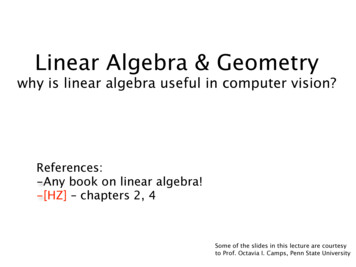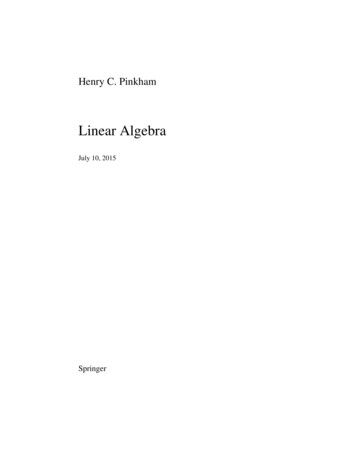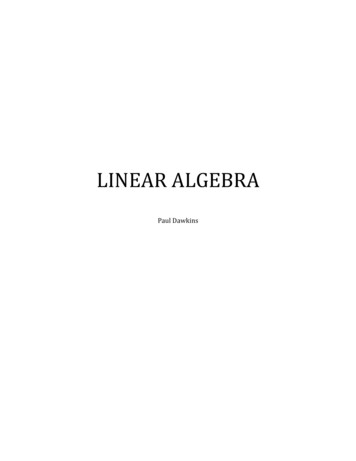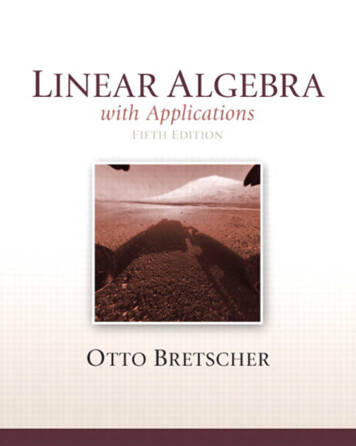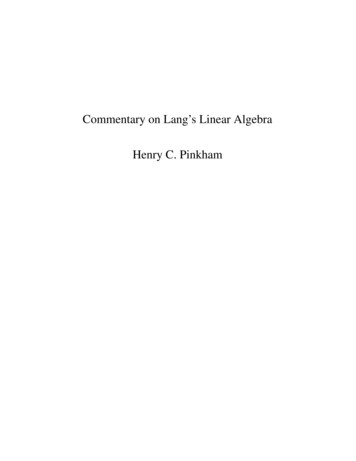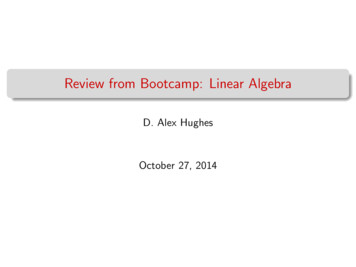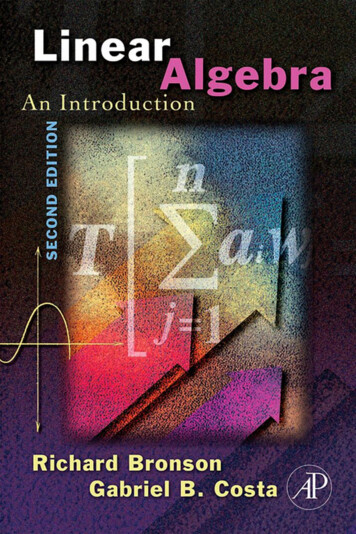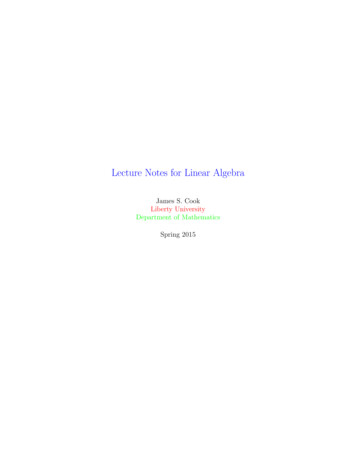
Transcription
Lecture Notes for Linear AlgebraJames S. CookLiberty UniversityDepartment of MathematicsSpring 2015
2prefaceBefore we begin, I should warn you that I assume a few things from the reader. These notes areintended for someone who has already grappled with the problem of constructing proofs. I assumeyou know the difference between and . I assume the phrase ”iff” is known to you. I assumeyou are ready and willing to do a proof by induction, strong or weak. I assume you know whatR, C, Q, N and Z denote. I assume you know what a subset of a set is. I assume you know howto prove two sets are equal. I assume you are familar with basic set operations such as union andintersection. More importantly, I assume you have started to appreciate that mathematics is morethan just calculations. Calculations without context, without theory, are doomed to failure. At aminimum theory and proper mathematics allows you to communicate analytical concepts to otherlike-educated individuals.Some of the most seemingly basic objects in mathematics are insidiously complex. We’ve beentaught they’re simple since our childhood, but as adults, mathematical adults, we find the actualdefinitions of such objects as R or C are rather involved. I will not attempt to provide foundationalarguments to build numbers from basic set theory. I believe it is possible, I think it’s well-thoughtout mathematics, but we take the existence of the real numbers as a given truth for these notes.We assume that R exists and that the real numbers possess all their usual properties. In fact, Iassume R, C, Q, N and Z all exist complete with their standard properties. In short, I assume wehave numbers to work with. We leave the rigorization of numbers to a different course.These notes are offered for the Spring 2015 semester at Liberty University. These are a majorrevision of my older linear algebra notes. They reflect the restructuring of the course which Iintend for this semester. In particular, there are three main parts to this course:(I.) matrix theory(II.) abstract linear algebra(III.) applications (actually, we’ll mostly follow Damiano and Little Chapters 4,5 and 6, we justuse Chapter 8 on determinants and §11.7 on the real Jordan form in the Spring 2015semester)Each part is paired with a test. Each part is used to bring depth to the part which follows. Just abit more advice before I get to the good part. How to study? I have a few points: spend several days on the homework. Try it by yourself to begin. Later, compare with yourstudy group. Leave yourself time to ask questions. come to class, take notes, think about what you need to know to solve problems. assemble a list of definitions, try to gain an inuitive picture of each concept, be able to giveexamples and counter-examples learn the notation, a significant part of this course is learning to deal with new notation. methods of proof, how do we prove things in linear algebra? There are a few standard proofs,know them. method of computation, I show you tools, learn to use them.
3 it’s not impossible. You can do it. Moreover, doing it the right way will make the courseswhich follow this easier. Mathematical thinking is something that takes time for most of usto master. You began the process in Math 200 or 250, now we continue that process.style guideI use a few standard conventions throughout these notes. They were prepared with LATEX whichautomatically numbers sections and the hyperref package provides links within the pdf copy fromthe Table of Contents as well as other references made within the body of the text.I use color and some boxes to set apart some points for convenient reference. In particular,1. definitions are in green.2. remarks are in red.3. theorems, propositions, lemmas and corollaries are in blue.4. proofs start with a Proof: and are concluded with a .However, I do make some definitions within the body of the text. As a rule, I try to put what Iam defining in bold. Doubtless, I have failed to live up to my legalism somewhere. If you keep alist of these transgressions to give me at the end of the course it would be worthwhile for all involved.The symbol indicates that a proof is complete. The symbol O indicates part of a proof is done,but it continues.reading guideA number of excellent texts have helped me gain deeper insight into linear algebra. Let me discussa few of them here.1. Damiano and Little’s A Course in Linear Algebra published by Dover. I chose this as therequired text in Spring 2015 as it is a well-written book, inexpensive and has solutions inthe back to many exercises. The notation is fairly close to the notation used in these notes.One noted exception would be my [T ]α,β is replaced with [T ]βα . In fact, the notation ofDamiano and Little is common in other literature I’ve read in higher math. I also liked theappearance of some diagrammatics for understanding Jordan forms. The section on minimaland characteristic polynomials is lucid. I think we will enjoy this book in the last third ofthe course.2. Berberian’s Linear Algebra published by Dover. This book is a joy. The exercises are challenging for this level and there were no solutions in the back of the text. This book is full ofthings I would like to cover, but, don’t quite have time to do.3. Takahashi and Inoue’s The Manga Guide to Linear Algebra. Hillarious. Fun. Probably abetter algorithm for Gaussian elimnation than is given in my notes.
44. Axler Linear Algebra Done Right. If our course was a bit more pure, I might use this. Verynicely written. This is an honest to goodness linear algebra text, it is actually just aboutthe study of linear transformations on vector spaces. Many texts called ”linear algebra” arereally about half-matrix theory. Admittedly, such is the state of our course. But, I have noregrets, it’s not as if I’m teaching matrix techinques that the students already know beforethis course. Ideally, I will openly admit, it would be better to have two courses. First, acourse on matrices and applications. Second, a course like that outlined in this book.5. Hefferon’s Linear Algebra: this text has nice gentle introductions to many topics as well asan appendix on proof techniques. The emphasis is linear algebra and the matrix topics aredelayed to a later part of the text. Furthermore, the term linear transformation as supplantedby homomorphism and there are a few other, in my view, non-standard terminologies. Allin all, very strong, but we treat matrix topics much earlier in these notes. Many theoremsin this set of notes were inspired from Hefferon’s excellent text. Also, it should be noted thesolution manual to Hefferon, like the text, is freely available as a pdf.6. Anton and Rorres’ Linear Algebra: Applications Version or Lay’s Linear Algebra, or Larsonand Edwards Linear Algebra, or. standard linear algebra text. Written with non-mathmajors in mind. Many theorems in my notes borrowed from these texts.7. Insel, Spence and Friedberg’s Elementary Linear Algebra. This text is a little light on applications in comparison to similar texts, however, the theory of Gaussian elimination and otherbasic algorithms are extremely clear. This text focus on column vectors for the most part.8. Insel, Spence and Friedberg’s Linear Algebra. It begins with the definition of a vector spaceessentially. Then all the basic and important theorems are given. Theory is well presented inthis text and it has been invaluable to me as I’ve studied the theory of adjoints, the problemof simultaneous diagonalization and of course the Jordan and rational cannonical forms.9. Strang’s Linear Algebra. If geometric intuition is what you seek and/or are energized by thenyou should read this in paralell to these notes. This text introduces the dot product earlyon and gives geometric proofs where most others use an algebraic approach. We’ll take thealgebraic approach whenever possible in this course. We relegate geometry to the place ofmotivational side comments. This is due to the lack of prerequisite geometry on the part ofa significant portion of the students who use these notes.10. my advanced calculus notes. I review linear algebra and discuss multilinear algebra in somedepth. I’ve heard from some students that they understood linear in much greater depthafter the experience of my notes. Ask if interested, I’m always editing these.11. Olver and Shakiban Applied Linear Algebra. For serious applications and an introduction tomodeling this text is excellent for an engineering, science or applied math student. This bookis somewhat advanced, but not as sophisticated as those further down this list.12. Sadun’s Applied Linear Algebra: The Decoupling Principle this is a second book in linearalgebra. It presents much of the theory in terms of a unifying theme; decoupling. Probablythis book is very useful to the student who wishes deeper understanding of linear systemtheory. Includes some Fourier analysis as well as a Chapter on Green’s functions.13. Curtis’ Abstract Linear Algebra. Great supplement for a clean presentation of theorems.Written for math students without apology. His treatment of the wedge product as an abstractalgebraic system is .
514. Roman’s Advanced Linear Algebra. Treats all the usual topics as well as the generalizationto modules. Some infinite dimensional topics are discussed. This has excellent insight intotopics beyond this course.15. Dummit and Foote Abstract Algebra. Part III contains a good introduction to the theory ofmodules. A module is roughly speaking a vector space over a ring. I believe many graduateprograms include this material in their core algebra sequence. If you are interested in going tomath graduate school, studying this book puts you ahead of the game a bit. UnderstandingDummit and Foote by graduation is a nontrivial, but worthwhile, goal.And now, a picture of Hannah in a shark,I once told linear algebra that Hannah was them and my test was the shark. A wise student prayedthat they all be shark killers. I pray the same for you this semester. I’ve heard from a certainstudent this picture and comment is unsettling. Therefore, I add this to ease the mood:As you can see, Hannah survived to fight new monsters.
6
ContentsImatrix calculation1 foundations1.1 sets and multisets . . . . . . . . . . . .1.2 functions . . . . . . . . . . . . . . . .1.3 finite sums . . . . . . . . . . . . . . . .1.4 matrix notation . . . . . . . . . . . . .1.5 vectors . . . . . . . . . . . . . . . . . .1.5.1 geometric preliminaries . . . .1.5.2 n-dimensional space . . . . . .1.5.3 concerning notation for vectors11.1313161922242426302 Gauss-Jordan elimination2.1 systems of linear equations . . . . . . .2.2 Gauss-Jordan algorithm . . . . . . . . .2.3 classification of solutions . . . . . . . . .2.4 applications to curve fitting and circuits2.5 conclusions . . . . . . . . . . . . . . . .313133394346.494951576061626667686869707275783 algebra of matrices3.1 addition and multiplication by scalars . . . . . . . . . . . . . .3.2 matrix algebra . . . . . . . . . . . . . . . . . . . . . . . . . . .3.3 all your base are belong to us (ei and Eij that is) . . . . . . . .3.3.1 diagonal and triangular matrices have no chance survive3.4 elementary matrices . . . . . . . . . . . . . . . . . . . . . . . .3.5 invertible matrices . . . . . . . . . . . . . . . . . . . . . . . . .3.6 matrix multiplication, again ! . . . . . . . . . . . . . . . . . .3.7 how to calculate the inverse of a matrix . . . . . . . . . . . . .3.7.1 concatenation for solving many systems at once . . . . .3.7.2 the inverse-finding algorithm . . . . . . . . . . . . . . .3.7.3 solving systems by inverse matrix . . . . . . . . . . . . .3.8 symmetric and antisymmetric matrices . . . . . . . . . . . . . .3.9 block matrices . . . . . . . . . . . . . . . . . . . . . . . . . . .3.10 applications . . . . . . . . . . . . . . . . . . . . . . . . . . . . .3.11 conclusions . . . . . . . . . . . . . . . . . . . . . . . . . . . . .7.
8CONTENTS4 linear independence and spanning4.1 matrix notation for systems . . . . . . . . . . . . . . . .4.2 linear combinations and spanning . . . . . . . . . . . . .4.2.1 solving several spanning questions simultaneously4.3 linear independence . . . . . . . . . . . . . . . . . . . . .4.4 The Column Correspondence Property (CCP) . . . . . .4.5 theoretical summary . . . . . . . . . . . . . . . . . . . .5 linear transformations of column vectors5.1 a gallery of linear transformations . . . . . .5.2 properties of linear transformations . . . . . .5.3 new linear transformations from old . . . . .5.3.1 composition and matrix multiplication5.4 applications . . . . . . . . . . . . . . . . . . .II.abstract linear algebra6 vector space6.1 definition and examples . . . . . . . . . . . . . . . . . . . . . . . .6.2 subspaces . . . . . . . . . . . . . . . . . . . . . . . . . . . . . . . .6.3 spanning sets and subspaces . . . . . . . . . . . . . . . . . . . . . .6.4 linear independence . . . . . . . . . . . . . . . . . . . . . . . . . . .6.5 bases and dimension . . . . . . . . . . . . . . . . . . . . . . . . . .6.5.1 how to calculate a basis for a span of row or column vectors6.5.2 calculating basis of a solution set . . . . . . . . . . . . . . .6.6 theory of dimensions . . . . . . . . . . . . . . . . . . . . . . . . . .6.6.1 application to fundamental matrix subspaces . . . . . . . .6.7 general theory of linear systems . . . . . . . . . . . . . . . . . . . .6.7.1 linear algebra in DEqns . . . . . . . . . . . . . . . . . . . .79808285869193.9595104107108109113.7 abstract linear transformations7.1 basic terminology . . . . . . . . . . . . . . . . . . . . . . . . . . . . .7.2 theory of linear transformations . . . . . . . . . . . . . . . . . . . . .7.3 matrix of linear transformation . . . . . . . . . . . . . . . . . . . . .7.4 coordinate change . . . . . . . . . . . . . . . . . . . . . . . . . . . .7.4.1 coordinate change of abstract vectors . . . . . . . . . . . . . .7.4.2 coordinate change for column vectors . . . . . . . . . . . . . .7.4.3 coordinate change of abstract linear transformations . . . . .7.4.4 coordinate change of linear transformations of column vectors7.5 theory of dimensions for maps . . . . . . . . . . . . . . . . . . . . . .7.6 quotient space . . . . . . . . . . . . . . . . . . . . . . . . . . . . . . .7.6.1 the first isomorphism theorem . . . . . . . . . . . . . . . . . .7.7 structure of subspaces . . . . . . . . . . . . . . . . . . . . . . . . . .7.8 examples of isomorphisms . . . . . . . . . . . . . . . . . . . . . . . .115. 116. 120. 124. 128. 132. 135. 138. 141. 147. 148. 150.151. 152. 153. 160. 166. 166. 167. 169. 172. 173. 177. 180. 183. 187
CONTENTSIII9applications1918 determinants8.1 a criteria for invertibility . . . . . . . . . . . . . . . . .8.2 determinants and geometry . . . . . . . . . . . . . . .8.3 cofactor expansion for the determinant . . . . . . . . .8.4 properties of determinants . . . . . . . . . . . . . . . .8.5 examples of determinants . . . . . . . . . . . . . . . .8.6 Cramer’s Rule . . . . . . . . . . . . . . . . . . . . . . .8.7 adjoint matrix . . . . . . . . . . . . . . . . . . . . . . .8.8 applications . . . . . . . . . . . . . . . . . . . . . . . .8.9 similarity and determinants for linear transformations8.10 conclusions . . . . . . . . . . . . . . . . . . . . . . . .9 euclidean geometry9.1 Euclidean geometry of Rn . . . . . . . . . . .9.2 orthogonality in Rn . . . . . . . . . . . . . . .9.3 orthogonal complements and projections . . .9.4 orthogonal transformations and geometry . .9.5 least squares analysis . . . . . . . . . . . . . .9.5.1 the closest vector problem . . . . . . .9.5.2 inconsistent equations . . . . . . . . .9.5.3 the least squares problem . . . . . . .9.6 inner products . . . . . . . . . . . . . . . . .9.6.1 examples of inner-products . . . . . .9.6.2 Fourier analysis . . . . . . . . . . . . .9.7 orthogonal matrices and the QR factorization.193. 193. 197. 199. 203. 208. 210. 214. 216. 219. 221.223. 225. 229. 239. 245. 247. 248. 249. 251. 257. 259. 262. 26410 complex vectorspaces26710.0.1 concerning matrices and vectors with complex entries . . . . . . . . . . . . . 26710.1 the complexification . . . . . . . . . . . . . . . . . . . . . . . . . . . . . . . . . . . . 26811 eigenvalues and eigenvectors11.1 why eigenvectors? . . . . . . . . . . . . . . . . . . . .11.1.1 quantum mechanics . . . . . . . . . . . . . .11.1.2 stochastic matrices . . . . . . . . . . . . . . .11.1.3 motion of points under linear transformations11.2 basic theory of eigenvectors . . . . . . . . . . . . . .11.3 complex eigenvalues and vectors . . . . . . . . . . .11.4 examples of real and complex eigenvectors . . . . . .11.4.1 characteristic equations . . . . . . . . . . . .11.4.2 real eigenvector examples . . . . . . . . . . .11.4.3 complex eigenvector examples . . . . . . . . .11.5 eigenbases and eigenspaces . . . . . . . . . . . . . . .11.6 generalized eigenvectors . . . . . . . . . . . . . . . .11.7 real Jordan form . . . . . . . . . . . . . . . . . . . .11.8 eigenvectors and orthogonality . . . . . . . . . . . .11.9 select applications . . . . . . . . . . . . . . . . . . .271272272272274278284288288289292295301305309310
10CONTENTS11.9.1 linear differential equations and e-vectors: diagonalizable case . . . . . . . . . 31211.9.2 linear differential equations and e-vectors: non-diagonalizable case . . . . . . 31412 quadratic forms12.1 conic sections and quadric surfaces . . . . . . . . . .12.2 quadratic forms and their matrix . . . . . . . . . . .12.2.1 summary of quadratic form analysis . . . . .12.3 Taylor series for functions of two or more variables .12.3.1 deriving the two-dimensional Taylor formula12.3.2 examples . . . . . . . . . . . . . . . . . . . .12.4 intertia tensor, an application of quadratic forms . .31531531632432532532632913 systems of differential equations13.1 calculus of matrices . . . . . . . . . . . . . . . . . . . . .13.2 introduction to systems of linear differential equations .13.3 the matrix exponential . . . . . . . . . . . . . . . . . . .13.3.1 analysis for matrices . . . . . . . . . . . . . . . .13.3.2 formulas for the matrix exponential . . . . . . .13.4 solutions for systems of DEqns with real eigenvalues . .13.5 solutions for systems of DEqns with complex eigenvalues13.6 geometry and difference equations revisited . . . . . . .13.6.1 difference equations vs. differential equations . .333334336338339340345352354354.
Part Imatrix calculation11
Chapter 1foundationsIn this chapter we settle some basic notational issues. There are not many examples in this chapterand the main task the reader is assigned here is to read and learn the definitions and notations.1.1sets and multisetsA set is a collection of objects. The set with no elements is called the empty-set and is denoted .If we write x A then this is read ”x is an element of A”. In your previous course you learned that{a, a, b} {a, b}. In other words, there is no allowance for repeats of the same object. In linearalgebra, we often find it more convenient to use what is known as a multiset. In other instanceswe’ll make use of an ordered set or even an ordered mulitset. To summarize:1. a set is a collection of objects with no repeated elements in the collection.2. a multiset is a collection of objects. Repeats are possible.3. an ordered set is a collection of objects with no repeated elements in which the collectionhas a specific ordering.4. an ordered multiset is a collection of objects which has an ordering and possibly hasrepeated elements.Notice, every set is a multiset and every ordered set is an ordered multiset. In the remainder ofthis course, we make the slight abuse of langauge and agree to call an ordinary set a set withno repeated elements and a multiset will simply be called in sequel a set. This simplifies ourlangauge and will help us to think better1 .Let us denote sets by capital letters in as much as is possible. Often the lower-case letter of thesame symbol will denote an element; a A is to mean that the object a is in the set A. We canabbreviate a1 A and a2 A by simply writing a1 , a2 A, this is a standard notation. The unionof two sets A and B is denoted2 A B {x x A or x B}. The intersection of two sets is1there is some substructure to describe here, multisets and ordered sets can be constructed from sets. However,that adds little to our discussion and so I choose to describe multisets, ordered sets and soon Cartesian productsformally. Formally, means I describe there structure without regard to its explicit concrete realization.2note that S {x R : x meets condition P } {x R x meets condition P }. Some authors use : whereas Iprefer to use in the set-builder notation.13
14CHAPTER 1. FOUNDATIONSdenoted A B {x x A and x B}. It sometimes convenient to use unions or intersections ofseveral sets:[Uα {x there exists α Λ with x Uα }α Λ\Uα {x for all α Λ we have x Uα }α Λwe say Λ is the index set in the definitions above. If Λ is a finite set then the union/intersectionis said to be a finite union/interection. If Λ is a countable set then the union/intersection is saidto be a countable union/interection3 .Suppose A and B are both sets then we say A is a subset of B and write A B iff a A impliesa B for all a A. If A B then we also say B is a superset of A. If A B then we sayA B iff A 6 B and A 6 . Recall, for sets A, B we define A B iff a A implies a B for alla A and conversely b B implies b A for all b B. This is equivalent to insisting A B iffA B and B A. Note, if we deal with ordered sets equality is measured by checking that bothsets contain the same elements in the same order. The difference of two sets A and B is denotedA B and is defined by A B {a A such that a / B}4 .A Cartesian product of two sets A, B is the set of ordered pairs (a, b) where a A and b B.We denote,A B {(a, b) a A, b B}Likewise, we defineA B C {(a, b, c) a A, b B, c C}We make no distinction between A (B C) and (A B) C. This means we are using theobvious one-one correspondence (a, (b, c)) ((a, b), c). If A1 , A2 , . . . An are sets then we defineA1 A2 · · · An to be the set of ordered n-tuples:nYAi A1 · · · An {(a1 , . . . , an ) ai Ai for all i Nn }i 1Notice, I define N {1, 2, . . . } as the set of natural numbers whereas Nn is the set of naturalnumbers upto and including n N; Nn {1, . . . , n}. If we take the Cartesian product of a set Awith itself n-times then it is customary to denote the set of all n-tuples from A as An :A· · A} An . ·{zn copiesReal numbers can be constructed from set theory and about a semester of mathematics. We willaccept the following as axioms53recall the term countable simply means there exists a bijection to the natural numbers. The cardinality of sucha set is said to be ℵo4other texts somtimes use A B A \ B5an axiom is a basic belief which cannot be further reduced in the conversation at hand. If you’d like to see aconstruction of the real numbers from other math, see Ramanujan and Thomas’ Intermediate Analysis which hasthe construction both from the so-called Dedekind cut technique and the Cauchy-class construction. Also, I’ve beeninformed, Terry Tao’s Analysis I text has a very readable exposition of the construction from the Cauchy viewpoint.
1.1. SETS AND MULTISETS15Definition 1.1.1. real numbersThe set of real numbers is denoted R and is defined by the following axioms:(A1) addition commutes; a b b a for all a, b R.(A2) addition is associative; (a b) c a (b c) for all a, b, c R.(A3) zero is additive identity; a 0 0 a a for all a R.(A4) additive inverses; for each a R there exists a R and a ( a) 0.(A5) multiplication commutes; ab ba for all a, b R.(A6) multiplication is associative; (ab)c a(bc) for all a, b, c R.(A7) one is multiplicative identity; a1 a for all a R.(A8) multiplicative inverses for nonzero elements;for each a 6 0 R there exists a1 R and a a1 1.(A9) distributive properties; a(b c) ab ac and (a b)c ac bc for all a, b, c R.(A10) totally ordered field; for a, b R:(i) antisymmetry; if a b and b a then a b.(ii) transitivity; if a b and b c then a c.(iii) totality; a b or b a(A11) least upper bound property: every nonempty subset of R that has an upper bound,has a least upper bound. This makes the real numbers complete.Modulo A11 and some math jargon this should all be old news. An upper bound for a set S Ris a number M R such that M s for all s S. Similarly a lower bound on S is a numberm R such that m s for all s S. If a set S is bounded above and below then the set is saidto be bounded. For example, the open set (a, b) is bounded above by b and it is bounded belowby a. In contrast, rays such as (0, ) are not bounded above. Closed intervals contain their leastupper bound and greatest lower bound. The bounds for an open interval are outside the set.We often make use of the following standard sets: natural numbers (positive integers); N {1, 2, 3, . . . }. natural numbers up to the number n; Nn {1, 2, 3, . . . , n 1, n}. integers; Z {. . . , 2, 1, 0, 1, 2, . . . }. Note, Z 0 N. non-negative integers; Z 0 {0, 1, 2, . . . } N {0}. negative integers; Z 0 { 1, 2, 3, . . . } N. rational numbers; Q { pq p, q Z, q 6 0}.
16CHAPTER 1. FOUNDATIONS irrational numbers; J {x R x / Q}. open interval from a to b; (a, b) {x a x b}. half-open interval; (a, b] {x a x b} or [a, b) {x a x b}. closed interval; [a, b] {x a x b}.We define R2 {(x, y) x, y R}. I refer to R2 as ”R-two” in conversational mathematics. Likewise, ”R-three” is defined by R3 {(x, y, z) x, y, z R}. We are ultimately interested in studying”R-n” where Rn {(x1 , x2 , . . . , xn ) xi R for i 1, 2, . . . , n}. In this course if we consider Rmit is assumed from the context that m N.In terms of cartesian products you can imagine the x-axis as the number line then if we pasteanother numberline at each x value the union of all such lines constucts the plane; this is thepicture behind R2 R R. Another interesting cartesian product is the unit-square; [0, 1]2 [0, 1] [0, 1] {(x, y) 0 x 1, 0 y 1}. Sometimes a rectangle in the plane with it’s edgesincluded can be written as [x1 , x2 ] [y1 , y2 ]. If we want to remove the edges use (x1 , x2 ) (y1 , y2 ).Moving to three dimensions we can construct the unit-cube as [0, 1]3 . A generic rectangular solid can sometimes be represented as [x1 , x2 ] [y1 , y2 ] [z1 , z2 ] or if we delete the edges:(x1 , x2 ) (y1 , y2 ) (z1 , z2 ).1.2functionsSuppose A and B are sets, we say f : A B is a function if for each a A the function fassigns a single element f (a) B. Moreover, if f : A B is a function we say it is a B-valuedfunction of an A-variable and we say A dom(f ) whereas B codomain(f ). For example,if f : R2 [0, 1] then f is real-valued function of R2 . On the other hand, if f : C R2 thenwe’d say f is a vector-valued function of a complex variable. The term mapping will be usedinterchangeably with function in these notes. Suppose f : U V and U S and V T then wemay consisely express the same data via the notation f : U S V T .Definition 1.2.1.Suppose f : U V . We define the image of U1 under f as follows:f (U1 ) { y V there exists x U1 with f (x) y}.The range of f is f (U ). The inverse image of V1 under f is defined as follows:f 1 (V1 ) { x U f (x) V1 }.The inverse image of a single point in the codomain is called a fiber. Suppose f : U V .We say f is surjective or onto V1 iff there exists U1 U such that f (U1 ) V1 . If a functionis onto its codomain then the function is surjective. If f (x1 ) f (x2 ) implies x1 x2for all x1 , x2 U1 U then we say f is injective on U1 or 1 1 on U1 . If a functionis inj
4.Axler Linear Algebra Done Right. If our course was a bit more pure, I might use this. Very nicely written. This is an honest to goodness linear algebra text, it is actually just about the study of linear transformations on vector spaces. Many texts called "linear algebra" are really about half-matrix theory. Admittedly, such is the state of .

